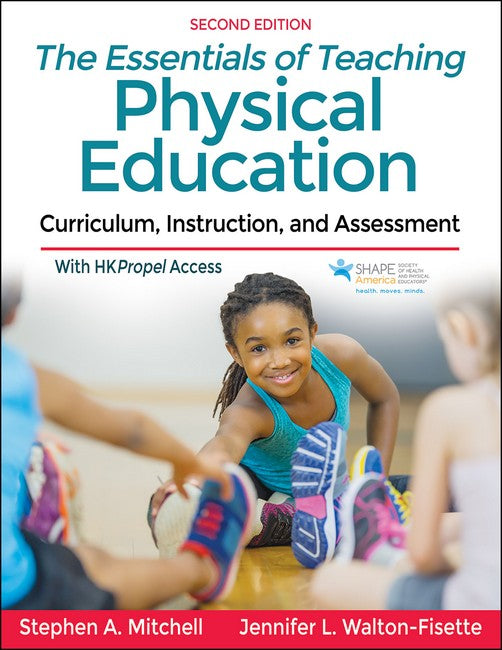Steve Mitchell, PhD, is a professor of physical education teacher education at Kent State University. He has BS and MA degrees in physical education and education from Loughborough University in England and a PhD in education from Syracuse University. Steve is lead author on Teaching Sport Concepts and Skills, also published by Human Kinetics-a book now in its fourth edition, with previous editions translated into Japanese and Korean. He has numerous refereed journal publications to his credit. He has also made dozens of keynote addresses and scholarly presentations. Steve is a member of SHAPE America, serving on many committees for that organization. He is a past president of the Ohio Association for Health, Physical Education, Recreation and Dance (OAHPERD). In 2005, he received the NASPE Physical Education Teacher Education Honor Award. Jennifer L. Walton-Fisette, EdD, is a professor of physical education teacher education in the School of Teaching, Learning, and Curriculum Studies at Kent State University. She obtained her BS in physical education from Rhode Island College, her MS in sport pedagogy from Ithaca College, and her EdD in physical education teacher education from the University of Massachusetts at Amherst. Jennifer has published four books and more than 40 research articles. She served as chair of the Research Council and is actively involved with SHAPE America, OAHPERD, and other associations. Her scholarship explores social justice, equity, and policy issues in physical education and PETE programs locally, nationally, and internationally. In recent years she has been especially active in the areas of social-emotional learning and trauma-informed teaching, and she is well-respected as an expert on these subjects.
Request Academic Copy
Please copy the ISBN for submitting review copy form
Description
Part I. Building the Foundation of a Teaching for Learning Approach Chapter 1. Developing Physically Literate Individuals Promoting Physical Literacy Academic Links to Physical Literacy Summary Chapter 2. Understanding a Teaching for Learning Approach Curricular Alignment in Physical Education Instructional Alignment in Physical Education Summary Chapter 3. Examining Student Motivation Establishing a Motivating Environment Retaining Students' Motivation Intrinsic Versus Extrinsic Motivation Eradicating Amotivation Summary Chapter 4. Understanding Social-Emotional Learning and Using Trauma-Informed Practices Social and Emotional Learning (SEL) Trauma-Informed Practices (TIPs) Becoming Self-Aware Through Critical Reflection Strategies on Fostering Resilient Learners Summary Part II. Teaching to the National Standards for K-12 Physical Education Chapter 5. Standard 1: Developing Motor Skills and Movement Patterns Competency Versus Proficiency Motor Skills and Phases of Performance Elementary School: K-Grade 5 Middle School: Grades 6-8 High School: Grades 9-12 Summary Chapter 6. Standard 2: Applying Concepts, Principles, Strategies, and Tactics Elementary School: K-Grade 5 Middle School: Grades 6-8 High School: Grades 9-12 Summary Chapter 7. Standard 3: Achieving Health-Enhancing Physical Activity and Fitness Elementary School: K-Grade 5 Middle School: Grades 6-8 High School: Grades 9-12 Summary Chapter 8. Standard 4: Exhibiting Responsible Personal and Social Behavior Elementary School: K-Grade 5 Middle School: Grades 6-8 High School: Grades 9-12 Summary Chapter 9. Standard 5: Recognizing the Value of Physical Activity Elementary School: K-Grade 5 Middle School: Grades 6-8 High School: Grades 9-12 Summary Part III. Building the Curriculum Chapter 10. Unit and Lesson Planning Unit Planning Lesson Planning Summary Chapter 11. Planning Developmentally Appropriate Content Types of Knowledge Standards, Outcomes, and Assessments Learning Domains Students' Prior Knowledge and Experiences Sequencing of Content and Task Progressions Modifying Content Summary Chapter 12. Curriculum Models as Organizing Frameworks Skill Theme Approach Teaching Personal and Social Responsibility Tactical Games Model Sport Education Model Fitness Education Adventure Education Outdoor Education Cultural Studies Implementing Curriculum Models Within Units of Instruction Summary Part IV. Instruction and Assessment Chapter 13. Establishing and Managing a Safe Learning Environment Setting Rules for Your Gymnasium Managing Student Behavior Maximizing Learning and Activity Time Managing the Learning Environment During Instruction and Activity Summary Chapter 14. Developing Essential Teaching Skills Exploring Instructional Styles Employing Effective Teaching Tactics Summary Chapter 15. Assessing Student Learning Purposes of Assessment Grading Schemes Selecting Appropriate Assessments Type of Assessments Organizing and Interpreting Data Summary Part V. Developing as a Professional Chapter 16. 21st Century Skills in Physical Education Framework for 21st Century Learning 21st Century Student Outcomes 21st Century Support Systems Summary Chapter 17. Advocacy, Professionalism, and Professional Development Advocating for Your Profession Professional Development Opportunities Summary

